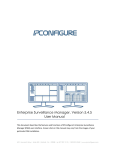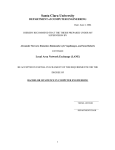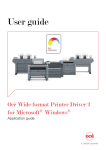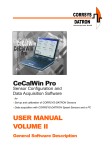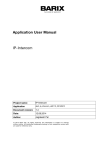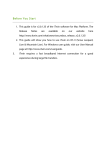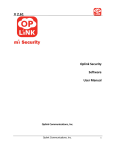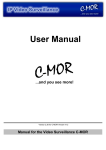Download ESM 6 User Manual
Transcript
Enterprise Surveillance Manager Version 6 Last Updated: Nov. 16, 2015 User Manual This document describes the features and functions for IPConfigure Enterprise Surveillance Manager (ESM) version 6’s user interface. 4211 Monarch Way | Suite 500 | Norfolk, VA 23508 | p: 877.207.1112 | f: 832.201.0342 | www.ipconfigure.com IPConfigure ESM v6.2 User Manual TABLE OF CONTENTS WORKSTATION PRE-REQUISITES 3 Hardware Requirements 3 Plugin Installation PAGE ELEMENTS 4 Navigation Tabs MAPS PAGE 5 Regional Maps 5 Building Maps MATRIX PAGE 6 Global Camera Directory 6 Layout Options 7 Multiple Monitor Support 7 Motion and Timed Cycles 7 Custom Layout & Current Selections ARCHIVE PAGE 8 Multi-Camera Search Timeline 8 Timeline Actions 9 Playlist 9 Archive Viewer 9 Skipping Between Motion Events 10 Exporting Video 11 Thumbnail Search 12 The Library ALARM PAGE 13 Setting an Alarm LPR PAGE 14 15 15 ESM MOBILE 16 Plate Search Real-Time Watch List ESM’s Mobile Interface IPConfigure ESM v6.2 User Manual Workstation Requirements ➽ Software Requirements Enterprise Surveillance Manager 6.0 can be viewed from workstations with the following M INIMUM requirements: OS: Windows 7 Pro 64-bit Browser: Internet Explorer 11 w/Flash Installed or Firefox (IE 11 Recommended) CPU: Intel Core i7 RAM: 8 GB Network: 1 Gbps Graphics Card: 1 GB onboard video memory ➽ Plugin Installation ESM uses a browser plugin called FBGST for recorded video playback in Internet Explorer and Firefox. When using Internet Explorer, a separate plugin called the Embedded Media Player is used for live-view playback. ESM will prompt you to install these plugins as needed after logging in: Click the blue FBGST link to download the FBGST browser plugin. Open and run the downloaded installer. When completed successfully, the installer will say P lease close all open browsers. Click the blue Embedded Media Player link to download the remaining plugin. Open and run the downloaded installer as you did for the FBGST plugin. When complete, click the Finish button and restart all open browsers. Note: You can skip the installation of these plugins by clicking the Skip button. Doing so will stream video via the JPEG Push HTML player which will show a lower framerate and quality video stream. IPConfigure ESM v6.2 User Manual Page Elements ➽ Navigation Tabs ESM provides five page navigation tabs within the browser window. These tabs allow for navigation between the different functions in the software: MAPS: Displays images of regional locations, buildings and floor plans where cameras and devices are present. Map images and camera icons are uploaded via ESM’s Administrator interface. If your Administrator has not uploaded maps then a placeholder map will be displayed by default. MATRIX: Shows live views of cameras which are selected from the Global Camera Directory. Custom camera layouts and camera views can be created and shared with other users. ARCHIVE: Enables users to search cameras for events such as Motion Detection, Contact Alarms, Video Loss and Video Restore. This page includes an embedded player for playback (Preview) or a separate pop-up window (View). Video clips can be sent to the Library for building case files and added to a Playlist to create one continuous clip from multiple clips. ALARM: This page displays various alarms such as motion detection, system errors, and alerts in a tabular format. Results can be filtered by Alarm Type and displayed by a user defined Refresh Rate. LPR: This page provides access to the license plate recognition software. The LPR tab may be grayed out (disabled) if LPR software is not licensed or the feature is not available to a particular user. IPConfigure ESM v6.2 User Manual Maps Page ➽ Regional Maps The map interface provides users with the ability to navigate through regional maps of ESM locations. The primary method of navigating is by selecting the blue Location icon , which allows the user to drill-down to any number of map layers. The Building Directory in the left hand column provides an alternative method to navigate to locations. Simply click on the name of the location in the left hand column and the map will be displayed. ➽ Building Maps A building map includes camera icons that represent the placement and orientation of cameras in the facility. Note: Maps and camera icons are loaded in the application by ESM Administrators. ➽ Live View - Mouse Over When the user’s mouse is placed over a camera icon live video will be displayed in a pop up window next to the icon. The same is true for PTZ camera icons . In addition, PTZ controls including presets (if defined by the ESM Administrator) will be available. Users can use their mouse to pan and tilt and mouse wheel to zoom in and out. Also keyboard keys can be utilized for zooming, (i.e. arrow keys, +/-). For faster movement, hold down the ctrl key and any combination of 2 other keys. ➽ Live View - Full Resolution To enlarge a live view, click on the camera icon. A separate pop-up window will be displayed on your screen. You may enlarge the window by pulling the lower right corner of the popup with your mouse or clicking on the maximize icon on the title bar of the window. You may also drag this window to another monitor. ➽ Pop Up Window Controls The addition of several camera controls in a full resolution pop up window helps to provide more clarity and ease of access. Whether or not these controls are enabled or visible may vary depending on several factors; in most cases users will see PTZ and audio controls. Matrix Page IPConfigure ESM v6.2 User Manual The Matrix page enables the user to view live video feeds from any location in various camera layouts. Additionally layouts can be customized and shared with other users. ESM has the capability of viewing up to 30 cameras on one monitor and a total of 120 using four monitors. ➽ Global Camera Directory The Global Camera Directory displays the locations, building and devices that are in use by ESM. Expand and collapse the directory by clicking the + button next to Corporate Locations. The directory is broken up by locations. Each section can be expanded or closed by clicking the + next to each location. Users can check and uncheck cameras from the directory to add or remove them from the screen. Example: A camera can be added to the Matrix page for viewing by clicking the checkbox for that camera in the directory. Clicking that checkbox again will uncheck the camera and remove it from the Matrix. To make the directory wider, mouse over the vertical frame to the right of the directory until the horizontal handle appears. Click and drag the handle to the desired width. ➽ Layout Options ESM provides three types of user defined layout formats: Full Screen , One-Up , and Grid Layout . Users can select the best viewing format for their surveillance needs. Different layouts can be combined when using multiple monitors. ➽ Multiple Monitor Support Each tab includes a small circle located on the bottom right of the tab. This button provides the ability to generate another copy or instance of that page. Users can select the new instance button and drag the new page to another monitor. Note: ESM can support up to 120 live camera views divided equally among 4 monitors (30 live cameras per monitor). In order to display 30 cameras per monitor, select the 6x5 grid layout from the Grid Layout drop IPConfigure ESM v6.2 User Manual down list. It is recommended that separate browser windows be opened when displaying ESM across multiple monitors. ➽ Motion and Timed Cycles Motion cycle rotates the cameras selected in the Global Camera Directory only when motion is detected. If motion is detected on more cameras than are available to be displayed based on the chosen layout, the cycling process will halt until any one of the actively displayed cameras ceases to detect motion. For example: The user has chosen a 2x2 grid and six cameras have been selected from the Global Camera Directory. Only after motion ceases to be detected by one of cameras being displayed in the 2x2 grid will another camera which has detected motion be able to take its place. Timed cycle rotates cameras selected in the Global Camera Directory based on a predefined interval. By default, the Timed Cycle interval is every 5 seconds. Users can select other intervals of 2, 5, 10 and 15 from the drop down list next to the Time Cycle option. Both Timed and Motion cycle options can be selected in the One-Up layout. This option rotates cameras in the larger window on a timed cycle and the smaller windows based on motion activity. Note: Users can arrange the order cameras are displayed in the matrix by reordering the list in the Current Selections pane. Click and drag the names of the cameras to the desired order. ➽ Custom Layout & Current Selections Users can create custom camera views and matrix layouts with Your Layouts. Furthermore Your Layouts can be shared with other ESM users. To create a custom layout simply right click on the Your Layout icon and select New Layout . You will be prompted to name Your Layout. Drag cameras from the Global Camera Directory into the Your Layout pane. To remove cameras from Your Layout right click and select Remove . To share and unshare Your Layout with other ESM users right click on Your Layout name and select Share or Unshare . Other options include Delete and Rename Y our Layout. Archive Page The Archive page enables users to search, playback, store and export recorded video. FBGST is used to playback video in ESM; however exported video can be played back with most WMV (Windows Media Video) capable media player. ESM uses an ASF (Advanced Streaming Format) file extension to encapsulate the WMV file. ASF is one of the streaming media formats that is supported by Windows Media Player. Tip: Users can also choose to playback exported video to another media player, such as VLC. IPConfigure ESM v6.2 User Manual ➽ Multi-Camera Search Timeline A search timeline provides a visual representation of the video events for cameras that are selected from the Global Camera Directory by the hour and minute. Users can search on four event types: Motion Detection, Contact Alarms (for Barix Barionet device), Video Loss , and Video Restored. Most commonly a search on Motion is represented by red dots while continuous recording (video recorded during times when no motion was detected) are represented by blue dots . To search for an event first choose the type of event(s). Next choose the camera(s) from the Global Camera Directory upon which to perform the search and click the Search button. Next choose the day on the calendar the event occurred (indicated by red numbers) to display the search results. Click another day to display its results. ➽ Timeline Actions Each hour offers a set of actions to the right: Preview , View , Send to Library , and Add to Playlist. Each hour provides a Start marker and a Stop marker that allows users to select a timeframe on the timeline for the purpose of preview, playback, export, and Library storage. Simply drag the start marker to the beginning minute where you want playback to start and the stop marker to the end. Preview: The Preview icon will display the video recorded between the start and stop marker on the video player at the top of the screen. This allows you to quickly play back video without having to open a new window or change screens. From this player, you can export video and skip between motion events, as you can with the pop out player. These features are explained in more depth in the Archive Viewer section of the manual. View: The View button opens the selected video in a pop up player and provides all of the same features as the preview player. When more than one camera is included in the search, the main View button for all of the cameras (appearing as the only button next to the main timeline for the hour’s search result) will open a player showing every camera. This allows you to review video from multiple cameras simultaneously. Note: If there is no event to view on a particular camera at the time designated, Camera Not Available will appear in the playback window. Send to Library: The Send to Library button allows users to send clips to the Library where they are stored indefinitely and can be shared with other users as well as viewed and exported. This is useful for retaining footage past the normal retention period that may be important in the future. IPConfigure ESM v6.2 User Manual Add to Playlist: The Add to Playlist button will send the selected archived video to the playlist of the preview player. Multiple clips from different hours or cameras can be sent to the playlist and played back one after another, providing another way to easily review footage from multiple cameras or different time frames. ➽ Playlist A Playlist in ESM is comprised of video clips that have been added by the user from a timeline search. Users create a Playlist when they wish to export individual video clips as one continuous video file. Clips in the Playlist can be rearranged using the Move Up / Move Down icons and deleted . Once the playlist is organized it can be exported by selecting the Export button. You will be prompted for a name and location for the video. Note: Your ESM Administrator may have disabled the Export Video feature if you are not prompted with a Save As dialogue box, or your browser may be blocking the download if JavaScript has been disabled. Tip: The contents of the Playlist can be cleared by clicking the Clear button. However, this feature does not delete the video clip from the system , rather, it removes it from the specific Playlist. All playlists are automatically purged when the user logs out of ESM. ➽ Archive Viewer The Archive Viewer provides playback functions for recorded video. You can perform basic video actions such as pausing/playing the video, or more advanced actions such as skipping between motion events or exporting video. ➽ Skipping Between Motion Events The next/previous buttons to the left and right of the play/pause button on the Archive Viewer player allows you to skip between motion events. This allows you to skip over video that was not tagged as having motion and only view video that had motion. An entire hour of video from a camera can be quickly reviewed with this feature. ➽ Capturing a Frame A frame can be captured from the Archive Viewer player by clicking the Capture Image button. Click this button to open the capture image window. The frame that was being played when the button was clicked will appear on the screen. Clicking the left or right arrow keys on the image will show either the previous or the next frame. IPConfigure ESM v6.2 User Manual The name for your captured image is set in the Name field Click the Download button to download the image. The Email and Print buttons can be used to email or print the image. Click the Edit image button to perform basic editing actions such as cropping, annotating, or rotating the image. The Position will tell you at what minute and second you are within the video being viewed. Note: Captured image quality is dependent on the recording resolution of the camera. Users can also send clips to the Library , then perform a Quick Export or Export as Evidence . ➽ Exporting Video Recorded video can be exported from ESM while playing back recorded video by clicking either the Download Video or the Download Evidence button. Clicking the Download Video button will open the Download Video window. This option allows to download the video from multiple minutes into one .ASF video file. The .ASF file can either be opened in Windows Media Player or other third party video players such as VLC. When playing back multiple cameras at once, the video from each camera can be downloaded individually by clicking the thumbnail for that specific camera. Video can also be exported by clicking the Download Evidence button. Clicking this button will open a window similar to the one that appears when clicking the Download Video button and allows you to export video from either one or multiple cameras. However, when using the Download Evidence option, the raw one minute video files will be downloaded, rather than the single combined video files. These video files will be included in a zip archive along with a .hsh file for each minute of video. The value in that file will match the SHA2 checksum of the corresponding video file, proving the video file has not been altered in any way after it was exported. This option is useful when exporting video for legal matters where proof may be required that the video was not altered after export. Users can also export all video associated with a selected camera by right clicking on the camera in the Global Camera Directory and selecting the Mass Export feature. All video associated with a selected camera will be exported as a compressed (zipped) file. The file will contain all one-minute videos (in the original folder structure) and a Windows Media playlist file. You will be prompted to name the file and specify the date range. Click the Export button to execute. IPConfigure ESM v6.2 User Manual ➽ Thumbnail Search Thumbnail search allows you to quickly find video clips of interest from a specific camera by displaying a thumbnail preview of each hour and minute of video recorded with motion. After clicking the Thumbnail tab and selecting a camera, thumbnail images will appear on the screen from every hour on that day that the camera had motion. Note: If the camera did not record any motion that day, a message will appear saying No motion events were found for the selected period. Please select a different camera or a different day. This message only means that the camera did not detect any motion; it may still be recording video. Click a thumbnail image, or its timestamp title, to view thumbnails from each minute in that hour. Clicking on a specific minute thumbnail with an hour will open that minute of video in a new window. Only minutes tagged as having motion will show a thumbnail in the list. IPConfigure ESM v6.2 User Manual ➽ Library The Library is a repository to save video clips that you do not want deleted once the camera hits its retention limit. Clips can be sent to the Library from a timeline search in the Search tab by clicking the Send to Library button, or by clicking the same button when playing back recorded video. All Library items show the date and time they were saved, the camera the clip is from and its location, a description of the video, the user that saved the video, as well as the duration and size of the video. By default, library items can only be viewed by the user that saved the clip. However, each Library item can be made public to other users by clicking the person icon under the Public column, and unshared by clicking the same button. ➽ Case Management Case management is a feature that allows you to edit Library items and add additional information. It can be accessed by clicking the Edit button that appears on each Library item line. Clicking that button will open the Edit Library window. From this window, you can add additional attachments that are relevant to the video, view image captures, add comments, and make it available to groups. Image captures included in the library item can be viewed by clicking the image’s thumbnail. After clicking the captured image, the capture image window that appears when capturing a frame during video playback will appear. This window will allow you to Download , Email , Print , or Edit the image as needed. IPConfigure ESM v6.2 User Manual Alarm Page The Alarm page provides ESM users with another way of searching and displaying alarms based on Motion Detection, System Errors such as a camera going offline, Alerts (when using a Barix device) and Updates to the system such as camera settings changing. ➽ Setting an Alarm To create an alarm, select the camera or device you would like to use to trigger the alarm from the Global Camera Directory. A list of recent events that can be used to trigger an alarm will appear on the screen. The type of event(s) you want to trigger the alarm can be selected using the list on the right-hand side below the filtering boxes. Select the type of event you want to trigger the alarm and the start and end period for the alarm. The list will update to match the filter you just set. Alternatively, you can set the filtering to l ive to see only the selected events in real-time. Alarm information is displayed on the page by Type (Motion, Error, Update, Alert) Timestamp, Source (Camera), Description, Status (On-Line/Off-Line), Device Name and Action. Users can View Event or View Details in the case of a Motion Event to display the video in a separate pop up playback window. The push pin icon locks the Filter and Page Setting frame on the page while the X collapses the frame. The down push pin indicates the frame is locked . To unlock the frame click the push pin again. IPConfigure ESM v6.2 User Manual LPR ESM can be used to view both server side LPR and IPConfigure's Embedded LPR, where the processing is handled on the camera. Recorded license plates can be viewed in real-time, specific plates can be searched for, or you can view all recorded plates that are on a watch list. Note: If the LPR tab does not appear in ESM, the system is either not licensed for LPR or the currently logged in user does not have access to view LPR results. ➽ Plate Search The Search tab can be used to search for specific plates: Select a LPR camera from the left-hand side tree. Enter the plate number you are searching for in the the Search Plate Number box. To view all results collected in the set time period, leave the search box empty. Select the Start Date and End Date (the default is the current day). If you want to search through a watch list, select the desired watch list in the Search Watch List dropdown. Click the Search button to perform the search. If there are results matching your search, they will appear above the search form. If no search results are found it will display No records to display. For each result, you can click the Preview Plate button to view the captured image of the plate at the top of the page along with the overview footage of the vehicle going by, if an overview camera is configured. The View Plate button will allow you to do the same thing, but in a separate window. The accuracy of the plate read can be verified using the Verify Plate button. With this option, you can see the actual image of the license plate and what LPR read the plate as, updating the plate as needed if there are any inaccuracies. Additional information such as the State, Country, and the Make, Model, and Color of the vehicle can also be added here. Add the plate to a Watch List by clicking the Add Plate to Watchlist button. Select the Watch List you want to add the plate to in the window that appears and then click Add to List . IPConfigure ESM v6.2 User Manual You can view a chart showing every time in the past 1, 7, 14, or 30 days a specific license plate has been detected by clicking the graph icon to the right of the add to Watch List button. This information can then be exported to several formats. Export the plate image by clicking the Export Plate Image button. If an overview camera is configured, you will be prompted to download the overview footage of the vehicle as well. Click Yes to download the corresponding overview footage or click N o to only download the plate image. ➽ Real-Time The Real-Time feature allows you to view recorded plates as they come in from multiple LPR cameras. This view shows you a raw image of the license plate’s text, the read text from the plate, the timestamp of when it was processed, as well as the location and camera that detected the plate. As with the search feature, you can manually verify each plate, add it to a watch list, view the plate’s statistics, and export the plate image. However, to view a preview of the plate, you will need to search for the plate using the search tab. By default, the Real-Time list is updated every 5 seconds. However, it can be paused, or increased incrementally up to 120 seconds by updating the Refresh Rate setting at the top of the list. ➽ Watch List The Watch List feature allows you to create lists of plates that are important in some way and should be tracked. Examples of Watch Lists would be important individuals or known suspects that are not allowed on-site. To add a Watch List, right click on Global Watch List on the left-hand side tree and click the Add button. Enter a list name and click okay to create the new list. Select the list from the tree to open it. Once open, you can specify an address to send email notifications to whenever a license plate on the Watch List is detected by LPR and a unique background color that will appear in Real-time and Search results containing a plate in the list. Add a new plate to the watch list by clicking the + button. Enter the license plate in the Plate Number column, the plate’s state in the Plate State column, then click the S ave button. Remove a license plate by clicking the Trash Can icon. You can view a chart showing every time in the past 1, 7, 14, or 30 days a specific license plate has been detected by clicking the graph icon to the right of the plate’s trash icon. This information can then be exported in several formats. A Watch List can be renamed or removed by right-clicking on the Watch List on the right-hand side tree view and clicking the Rename or Delete buttons. IPConfigure ESM v6.2 User Manual Mobile Interface ➽ ESM Mobile ESM Mobile allows for the availability to view live streams from your cameras using the browser on any iOS or Android device, such as an iPhone or Nexus phone. Go to the address of your ESM server. If it is only available internally, make sure your device is connected to a WiFi network that has access to the ESM server. Login to ESM with your regular user ID and password as you would normally from a regular browser. Once logged in, a Global Locations tab will appear. Click on this tab and then click the appropriate sub-location that houses the camera you would like to view. The location the camera is under will match the location it is under when viewing ESM in a regular browser. Tap the camera you would like to view to bring up a live stream. The camera will start streaming and from here, you can play and pause the recording as needed and view it in fullscreen.

















